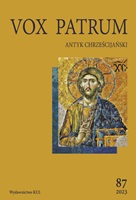„Ozdobiona wszelkimi cnotami” cesarska siostra Pulcheria i „roztropna” cesarzowa Atenais-Eudocja – co o epoce Teodozjusza II wiedzieli Słowianie prawosławni w średniowieczu?
“Adorned with All Virtues” Emperor’s Sister Pulcheria and the “Prudent” Empress Athenais-Eudocia – What Did the Orthodox Slavs Know in the Middle Ages about the Times of Theodosius II?
Author(s): Zofia A. Brzozowska, Mirosław J. LeszkaSubject(s): Cultural history, Social history, Russian Literature, 6th to 12th Centuries, 13th to 14th Centuries, 15th Century, Sociology of Religion, History of Religion, Sociology of Literature
Published by: Katolicki Uniwersytet Lubelski Jana Pawła II - Wydział Teologii
Keywords: Pulcheria; Athenais-Eudocia; Theodosius II; Old Rus’ literature;
Summary/Abstract: The image of the Byzantine Empire in the mid-fifth century and the perception of its rulers in the Old Rus’ writing was formed on the basis of the Orthodox Slavonic translations created in the Balkans of the works of three Byzantine historians: John Malalas (sixth century), George the Monk called Hamartolos (ninth century), and Constantine Manasses (twelfth century). The use of their accounts by the authors of chronicles, even in the second half of the 16th century, testifies to the exceptional longevity of Byzantine hi-storiography and the peculiar timelessness of the works of the aforementioned historians. It should be noted, however, that Pulcheria, Theodosius II, Athenais-Eudocia and Marcian did not only attract the attention of Old Rus’ historiographers as persons with real influen-ce on the course of events in the past. Orthodox Slavs of the late Middle Ages viewed the mid-fifth century primarily as the era of the great disputes over the nature of Christ, culmi-nating in the convening of the ecumenical councils of Ephesus (431) and Chalcedon (451). Some of the emperors and empresses involved in the theological controversies of their time were venerated as saints in the realm of Slavia Orthodoxa. Analysis of the Old Rus’ chronicles from the 14th-16th centuries allows us to assume that hagiography influenced the creation of the images of such figures in historiography. In order to reconstruct the overall image of Pulcheria and Athenais-Eudokia in Old Rus’ literature, it would therefore be necessary to examine the hagiographic texts dedicated to them.
Journal: Vox Patrum
- Issue Year: 2023
- Issue No: 87
- Page Range: 217-246
- Page Count: 29
- Language: Polish

